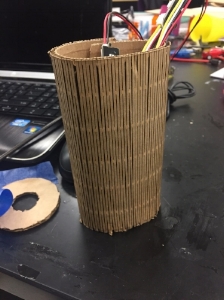Dream Toy Project: Magic Counting Wand
Role: team member
Course: Educ 211/236 - BEYOND BITS AND ATOMS
overview
For our project in this class, we were tasked with designing a dream toy for a child. We worked with Sophie, a five-year old girl, who enjoys playing make-believe and is learning to count. When she plays pretend, she especially enjoys playing with princesses and fairy tales. We conducted several user interviews and tests with Sophie to design her Dream Toy: A Magic Counting Wand.
This is a physical wand that will be crafted using laser cuts and glue for a more precise design. For our low-resolution prototype, we used cardboard and paper materials. Our overarching aim is to abstract her interest in counting through a tool that provokes imagination and enhances her make-believe stories. Because the process of storytelling in how she plays make believe seems to be limited to her own reality or the reality of her parents’ lives, one learning goal of this toy is to push the boundaries of her storytelling beyond this current lens to a more creative frame of thinking. She already seems to have some interest in fantastical characters like queens and princesses, and we chose to create a magic wand to enhance that aspect of her imagination. The second primary learning goal of this toy is the math element where we add a layer of complexity to her counting concepts by abstracting numbers through the form of light and touch.
Our final product is a mixed media wand that uses a proximity sensor and LED lights. For a specific set of times that the wand touches an object, an LED light blinks for the corresponding number of touches. One light turns on and blinks for every odd number and a second for every even number. In addition, my recorded voice also plays to voice the first 10 counts out loud to make the primary learning aims more explicit. We decided to use blinking lights because they allow for a rhythmic mode of counting that aligns to Sophie’s musical interests. In this way, she begins to recognize numbers represented in other forms and is introduced to more advanced math concepts like patterns and multiples.The interaction of this toy can manifest in two different ways. First, it can be used as she plays games of pretend as an object that enhances the craft of her story-telling. Secondly, it can be used specifically for the purposes of learning about math through experimentation and exploration.
first use video
Sophie was given this toy to keep after the finale of this project. This is her first use of the product in our lab!
iteration of full product
Left to Right: Version 1 - 3
Demo video of magic counting wand function
magic wand base
Lasercut Cardboard Base holds programmed GoGo Board, voice recorder, speaker, portable charger
iteration of star
Right to Left: Version 1-3, Acrylic 3-layered star with LED lights and a proximity sensor
iteration of rod
Top to Bottom: Version 1-3, Laser cut wood and cardboard rod








